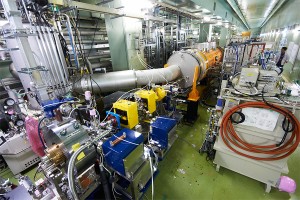On 13 April at KEK’s superconducting radiofrequency test facility (STF), researchers successfully transported beam to the beam dump. The dump, located in the last part of the accelerator, is designed to absorb the energy of particles within accelerated beam. Now STF is no longer a test facility: it is the STF accelerator.
STF is an important facility for ILC R&D on superconducting RF accelerating systems. Scientists have been conducting an array of R&D and tests towards beam operation of the accelerator for the Quantum Beam Project. The aim of this project is to develop a compact and high-quality X-ray source for use in broad areas such as medicine, life science, information technology, nanotechnology and quantum science.
Full-scale remodeling of the test facility into an accelerator started in 2011. Two superconducting accelerating RF cavities were loaded into a cryostat and installed in the beamline. The photocathode RF electron gun for producing low-emittance beam was placed at the upper stream of the cryostat, and the focus beamline for the compact, high-flux X-ray source was set in place at downstream.
“We worked on the improvement of our electropolishing facility in parallel with accelerator development,” said Hitoshi Hayano, professor at KEK’s accelerator laboratory, who leads the R&D at STF. To realise the high accelerating gradient, it was important to maintain the smoothness and cleanliness of the cavities’ inner surfaces, as well as the purity of the niobium, the cavity material.
“We introduced a new rinsing method, using detergent to get rid of residue, such as niobium oxide or sulfur particles, leftover from electropolishing. We also optimised the subsequent baking process in the cleanroom so that we could prevent the melting of the indium coating on the Helicoflex seal,” said Hayano. As a result of these optimisations, researchers realised the high gradients for two cavities installed in STF accelerator: 40 and 33 megavolts per metre (MV/m), well over the ILC specification of 31.5 MV/m.
On 12 April, scientists finished the final setup of the two nine-cell cavities and started beam operation with the RF electron gun and the cavities. They confirmed the successful acceleration and transportation of the beam to the beam dump the very next day.
Scientists are planning to install an optical cavity for laser beam accumulation during the short shutdown in May. This optical cavity is another critical component for producing high-intensity X-rays. They developed a four-mirror cavity system that circulates and stores the laser pulses. The beam operation with the four-mirror cavity is planned to begin running in June with a goal to demonstrate high-flux X-ray generation using inverse Compton scattering.
“This is a wonderful R&D milestone toward realising the ILC,” said Akira Yamamoto, project manager of the Global Design Effort and head of KEK’s linear collider office.


Recent Comments